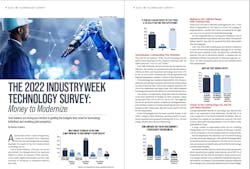The 2022 IndustryWeek Technology Survey: Money to Modernize
A heavier dose of the C-suite, hiring booms, a return to automated form, happiness with IIoT and new budgets for technology highlight the results of the 2022 IndustryWeek Technology Survey.
Tech is about evolution. This year, our survey also evolved. We changed some of our questions slightly to reflect the nuances of how manufacturers deploy digital technologies and how roles continue to transform as companies embrace new tools.
Technologies Commanding Your Attention
This year for the question “What current technology do you think is most important to your company’s future success?” we added choices for “AR/VR” and “Other.”
Even with additional choices to spread out the response distribution, the number of manufacturers placing automation/robotics as their most important technology went from 37% in 2021 to 41% in 2022. However, only 21% of respondents that deployed automation consider it critical to their businesses.
This technology was considered important for 54% of respondents who also said their businesses could function without robots on most production lines. Robots had marginal importance for 25% of the respondents that deploy them, with robots deployed for testing purposes but not relied on for core business functions.
The number of respondents citing data analytics solutions as the most important technology for their company’s future success sank from 32% in 2021 to 15% in 2022. We might lay this on the decreased number of enterprise management/analytics software creators or vendors answering this year’s survey because as later results show, Big Data is still clearly a priority for our respondents.
Green technologies were the most common answer in the “other” category, likely reflecting a growing priority for automotive manufacturers gradually phasing from ICE to EVs and energy-efficient smart factory engineering.
Mellow on IIoT, Still Not Ready with Cybersecurity
Most of our IIoT data is relatively unchanged from 2021. A full third of respondents in 2022 have no current IIoT strategy or implementation. Another third either are waiting for the right use case or are in a proof of concept/planning stage.
For the companies that are running IIoT initiatives, 42% of respondents felt their expectations were met, while 53% reported feeling “neutral” and only 5% answered that their expectations were not being met.
Only 25% of this year’s respondents cite extreme confidence in their cybersecurity preparedness, although it’s an increase from last year’s response of 20%. We altered the cybersecurity question this year to ask plainly whether a company had not established cybersecurity protocols: 7% chose that response. Another 13% have protocols in place but are not confident about their preparedness.
Closer To the Cutting Edge: 5G, AR/VR and Vision Systems
Among respondents who felt 5G technology was relevant (18% said it’s not important to their industries), 30% felt that 5G is a key component of the fourth industrial revolution, 38% are interested but waiting for successful use cases and 32% need to learn more before deciding whether or not 5G offers a value proposition for them.
A large number of respondents (46%) cite not knowing enough about AR/VR to have an opinion on the topic. Another 13% see no benefits to the technology or feel it is a waste of time. For the respondents who did think AR/VR is worth looking at or who are already deploying it, 40% feel the technology offers increased production and efficiency, 34% feel AR/VR can provide an increase in actionable data and 26% feel the technology provides safety benefits.
We added a question this year about the primary purpose for which manufacturers employ vision systems, and a full 51% of respondents said that they do not employ vision systems at all. According to Michael Larner, Industrial & Manufacturing principal analyst at ABI Research, this potentially indicates companies not investing in the connectivity infrastructure to stream images.
“In addition, the respondents haven’t dedicated the time and resources to train machine learning algorithms to analyze the images coming from a vision system on the production line to, for example, identify defects,” Larner says.
Vision-based quality inspection applications are employed by 31.2% of our respondents. Industrial autonomy was cited by 9% as their chief use for vision, with 5% using the technology for logistics and warehousing and only 2% using vision technology for pick-and-place. More than half say they don’t use vision systems.
Technology Leadership Challenges
In 2021, 42% of respondents cited finding money in the budget or proving reasonable ROI as the primary leadership challenges when implementing new technologies in their plants. In 2022, this number sank to 35%. The percentage of respondents citing moving a new technology from a pilot phase to deployment at scale as their chief leadership challenge sank from 13% in 2021 to 7% in 2022.
We also saw a sizeable change in the percentage of respondents citing training employees, customers or partners how to use new technology as their No. 1 leadership challenge: This rose from 19% in 2021 to 26% in 2022.
“There’s several aspects in the answers to that question,” Larner says. “Regarding training employees, a mismatch between expectations of employees and management with regards to training delivery, e.g., self-paced digital tools compared with formal classroom-style delivery. The challenge must also be that the adoption of hybrid and flexible working, post pandemic, requires leaders to manage in different ways.
“Regarding training customers, challenges may be similar in terms of knowledge delivery. Also, customers expect the solution to work straightaway and may not be prepared to dedicate time/resources to training–especially given other priorities at the moment regarding supply chain, inflation, etc.,” Larner continues.
“Regarding partners, they may be technology savvy and want to use low code/no code tools which respondents may not have,” Larner adds. “Dynamics may have changed with partners evaluating other options and respondents having less influence than before.”
Manufacturing professionals (OT) take a widening set of responsibilities in today’s technology initiatives, and we accordingly widened the answers to our question on how those professionals participate in strategic decisions.
Their most significant role is in the selection of new hardware, followed by selection of new software and strategic planning for purchasing and plans for expansion. Manufacturing professionals are less likely to be involved with cybersecurity planning, personnel structuring (new/temp hires or reorganizing existing employees) and least likely to be found leading digital transformation initiatives.
When prioritizing the benefits of the latest technologies for their businesses, improving OT operations and performance levels was cited as the highest priority on a much higher weighted average than in 2021.
This year’s results for which technologies will drive investment at our respondents’ organizations in the next 12 months reverses last years’ results, with robotics and automation taking the top slot in 2022 over data analytics.
Finally, when asked about their top strategic priority for technology deployment over the next 12 months, more than one-third (36%) of respondents will prioritize upgrading their existing manufacturing technology investments. The No. 2 response, “adding new technologies to enable innovation/competitive differentiation,” came in at 32%, a substantial rise from last year when only 22% chose this response.
Demographics Changes
The demographics of our respondents haven’t changed appreciably from 2021. Only two changes popped out. The number of CEOs and presidents rose from 17% last year to 23% this year, and manufacturing/ production managers slipped from 14% of our respondents in 2021 to 9% in 2022.
The number of respondent companies identifying as primary and fabricated metal manufacturers rose from 15.47% in 2021 to 20.10% in 2022, and the number of enterprise management/analytics software creators or vendors sank from 6.08% of respondents in 2021 to 3.43% in 2022.
We had quite a few changes in the locations of our respondents, the most noticeable being decreases in businesses from South Atlantic states (15% in 2021 to 10% in 2022) and Europe (8% in 2021 to 3% in 2022). The number of respondents hailing from New England rose from 3% in 2021 to 6% in 2022 and from North Central states, from 25% in 2021 to 31% in 2022.
Reported sales volumes from respondents in 2022 were largely the same as in 2021 other than a decrease in business with volumes of $1 billion and above, shifting from 18.78% in 2021 to 13.93% in 2022.
Far fewer businesses reported having more than 10,000 employees (14% in 2021 to 7% in 2022), and the number of businesses reporting 251 to 1,000 employees jumped from11% in 2021 to 17% in 2022.
The final, basic demographic question posed in the survey is whether employment increased or decreased in 2021. The businesses reporting increased employment rose dramatically from 28% in 2021 to 44% in 2022.
Download the full report with data not covered in this story here.
About the Author
Dennis Scimeca
Dennis Scimeca is a veteran technology journalist with particular experience in vision system technology, machine learning/artificial intelligence, and augmented/mixed/virtual reality (XR), with bylines in consumer, developer, and B2B outlets.
At IndustryWeek, he covers the competitive advantages gained by manufacturers that deploy proven technologies. If you would like to share your story with IndustryWeek, please contact Dennis at [email protected].

